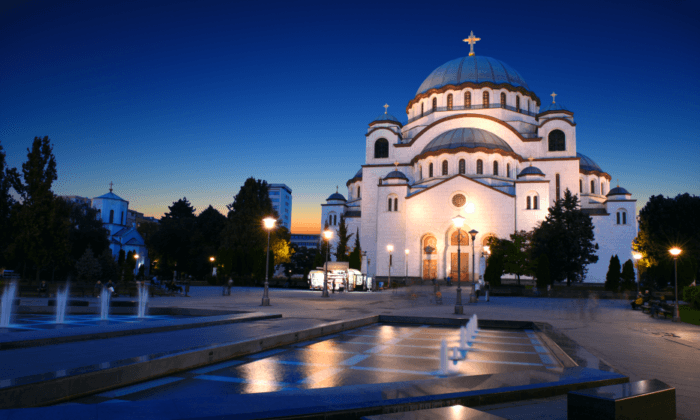I approached through the Istanbul gate. For hundreds of years, this city was one of the westernmost prizes of the Ottomans, with a road that ran straight from here to the capital of the empire. The doors still bear the signs of conflict, bullet holes in the tough black steel.
“This city has seen 115 wars, and this fortress has been demolished completely more than 40 times,” noted my guide, Dragana.
The grounds are green, dotted with statues and walls and towers, the whole place feeling more like a park, everything bright and happy on a sunny afternoon in the late fall, all of it belying the fierce fighting that has taken place here so many times.
“And now, we will see the source of it all,” explained Dragana, bringing our small tour group to the crest of a rise. Below us, the confluence of two mighty rivers, the Sava, and the Danube, the latter the longest in Europe, save for the Volga in Russia. Control of the water came with great prizes—taxation, trade, and military supremacy—and so the world often came here to Belgrade, in order to vie for control of it all.
“Across there, we call that Big War Island, because that’s usually where the attacks started,” Dragana said. Today it looks lovely, green forest fringed by the blue of the rivers.
Just mention the name of some European capitals, you’ll conjure many romantic images. Paris: a stroll by the Seine, passing under Pont Neuf, the bateaux mouches rolling by. Rome: the rise of the Coliseum, the great dome at St. Peter’s, navigating ancient streets that once led everywhere in the world. Even Budapest, divided by the Danube: the Chain Bridge bringing everything together, Buda and Pest climbing away on each side of the flow.
But, in the west, Belgrade is known mostly for war. Once the capital of a united Yugoslavia (now fragmented into six separate republics), this city of 1.8 million has a long history, and many stories to tell. Still the capital of Serbia, most recently the Yugoslav Wars tore this region apart between 1991 and 1999, with fighting in Slovenia, Croatia, Bosnia, and Kosovo. It is worthwhile to explore this history, and a visit will quickly reveal that the city still bears its scars, most notably buildings partially demolished and not yet rebuilt from NATO bombs in 1999.

However, you’ll find far more than military history here. A green city dotted with parks, it’s also very blue, with two rivers providing plenty of opportunities to get out on the water. Even the Belgrade Fortress, first built in 279 B.C. on a promontory there at the confluence, feels like a good place for a picnic.
Close to the city core—no more than 10 or 15 minutes by car—downtown Belgrade is bustling and broad-shouldered, if not beautiful. A meeting point of east and west, signs are posted two alphabets, Cyrillic and Latin. Bell towers rise, as do minarets. Streets slope up, inland, away from the rivers. The domes at the Church of Saint Sava were completed just in 2020, almost a century in the making. Inside, everything feels a little like Hagia Sofia, the image of Christ, sparkling and golden, staring down from up high. Everyone who enters, even a group of teenage boys, kisses the icon of the patron saint.

In the heart of town, pedestrian shopping streets channel foot traffic away from the main thoroughfares, which heave with a seemingly endless string of city buses. Republic Square hosts both the National Museum and National Theatre, the latter opened in 1868 and modeled on La Scala in Milan. Having walked, and shopped, and explored, at the end of the day, it was time to settle down and enjoy a taste of the country’s national beverage.
The storefront was small, but the welcome warm, from Djordje, pronounced “George.” He had only worked for Rakia Bar for a couple of months. “But this passion, it’s been all my life,” he explained, noting that most families in Serbia make their own signature versions of this fruit brandy, grandfathers minding the wood-fired stills, kids sent out to forage for sticks and other flammable materials to keep the fire going.
I tried various versions—quince, apricot, and plum, the most common type. The growing conditions in southern Serbia are ideal for these fruits, making it, in his opinion, the best rakia on earth. The snifters were warming, and the conversation grew with every drink, the talk revolving around culture and place. “We have a saying here—rakia connects people,” said Djordje, and in that cozy little bar, the chilly night waiting outside, it felt rather appropriate. While Belgrade has seen many wars arrive on its rivers, tonight, it was all peace—a good drink, with a great chat, in the heart of an underrated European capital.






